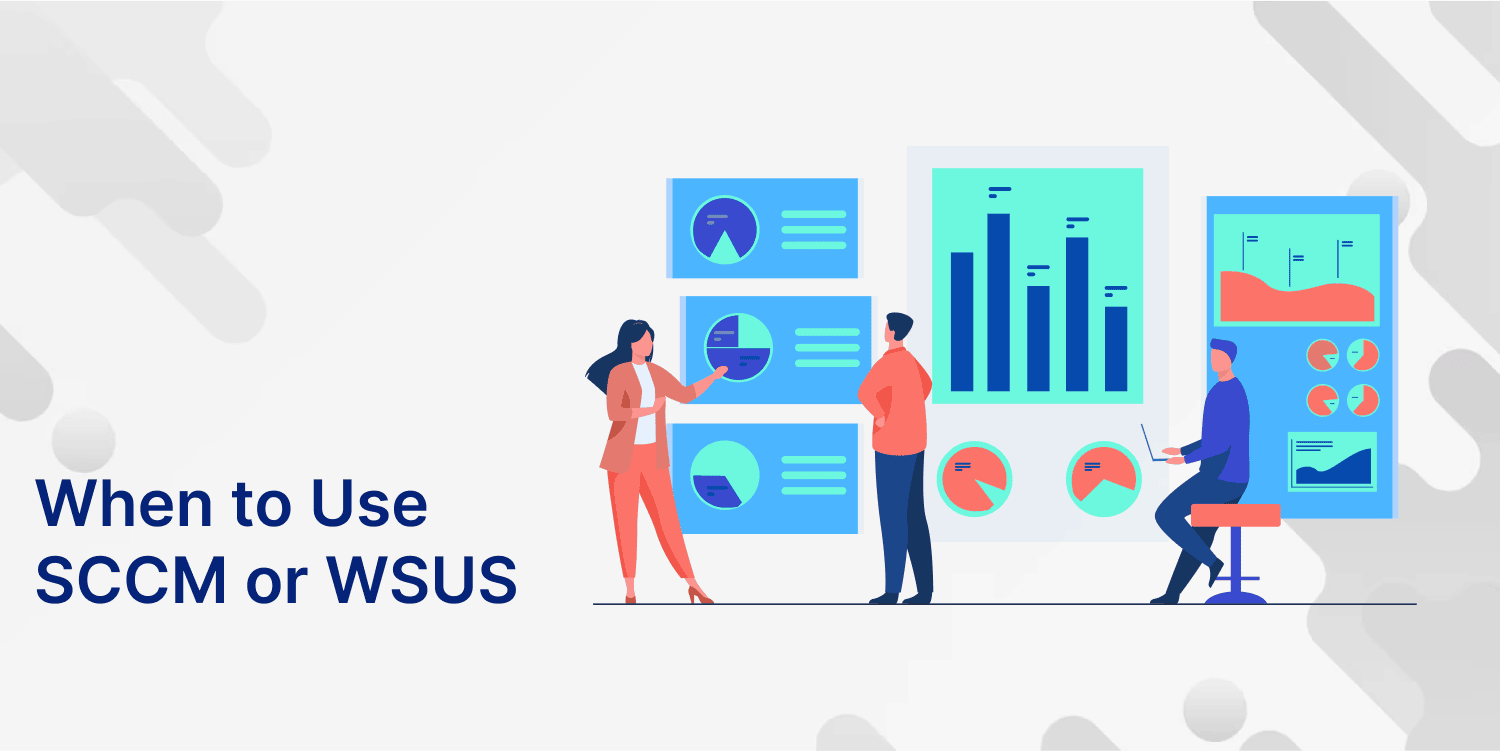SCCM vs WSUS: A Guide for Expert Software Update Management
As technology advances, what tools stand out as the guardians of system health and security? This is the question that drives our exploration of system management tools. Two main options stand out among many: Microsoft’s System Center Configuration Manager (SCCM) and Windows Server Update Services (WSUS). But how can organizations discern which tool aligns best with their unique needs?
This blog post, authored by Easy2Patch experts, explores the difference between SCCM and WSUS through a comparative analysis. Additionally, it's important to consider the role of third-party patch management via SCCM or WSUS in ensuring comprehensive system security and stability. Whether you're a seasoned IT pro or a newbie eager to master system management, come along as we break down these essential tools. Let's explore and learn! Head over to the first section on "SCCM vs. WSUS: An In-Depth Comparison" to dive deeper into their differences. And stay tuned for insights on how Easy2Patch can revolutionize your patch management process.

SCCM vs. WSUS: An In-Depth Comparison
The choice between SCCM and WSUS hinges on the specific needs and budgetary constraints of the organization. Organizations must weigh the trade-offs between functionality and cost to determine the most suitable solution for their environment. When organizations deal with managing systems, it's crucial to grasp the differences between SCCM and WSUS. Both help handle operating systems, updates, and software, but they have unique features and suit different organizational requirements.
The fundamental difference between SCCM and WSUS lies in their intended use and complexity. SCCM serves as a comprehensive system management software with extensive control over patch deployment, integration with WSUS, and support for third-party software patching. On the other hand, WSUS functions as a remote administration software focused primarily on Windows patch management, offering simplicity and ease of use. Delve deeper into their disparities with our comprehensive comparison table below:
| Feature | SCCM | WSUS |
|---|---|---|
| Deployment | Comprehensive, and supports deploying software updates, applications, drivers, and operating systems. | Primarily focused on deploying Microsoft updates. |
| Management | Centralized management of endpoints, with extensive reporting and compliance features. | Limited management capabilities, primarily for updates. |
| Scalability | Suitable for large enterprises, capable of managing thousands of endpoints efficiently. | Designed for smaller to mid-sized environments; may face challenges with scalability in large deployments. |
| Automation | Offers extensive automation capabilities, including scheduling updates, targeting specific groups, and automated remediation. | Lacks advanced automation features, and primarily relies on manual approval and deployment. |
| Track and Document Patching Progress | Document the status of patch deployment and deviations from standard procedures. Use dedicated tools to track progress and maintain an audit trail. | Facilitates tracking of patching status across systems. |
| Granularity | Provides granular control over update deployments, allowing customization based on organizational needs. | Limited granularity, primarily offering options for approval and deployment. |
| Patch Testing | Supports comprehensive testing workflows, allowing organizations to test updates before widespread deployment. | Limited testing capabilities, primarily relying on manual testing outside of the WSUS environment. |
| Integration | Integrates seamlessly with other Microsoft technologies and services, such as Active Directory, Service Manager, Intune, and Azure. | Limited integration options beyond the Windows ecosystem. |
| Cost | Typically its higher initial investment is due to licensing costs, but offers broader functionality. | The lower initial investment, as WSUS is included with Windows Server licenses, may require additional tools for comprehensive management. |
Discover more about Microsoft device management tools with Easy2Patch's comprehensive guide, "SCCM vs. Intune," and explore the comparison between SCCM and Intune to uncover valuable insights, refining your device management strategy in the process.
Exploring User-Friendliness and Scalability of SCCM and WSUS
In this section, we delve into a comparative analysis of SCCM and WSUS, focusing on two critical aspects: ease of use and scalability. User-friendliness encompasses factors such as the learning curve and the intuitiveness of the user interface. Scalability examines the capacity of each solution to accommodate the needs of networks varying in size and complexity.
User-Friendliness
Learning Curve:
- WSUS: WSUS provides a relatively easy setup and operation, serving as a no-cost add-on integrated into the Windows operating system. It facilitates the rapid deployment of updates, patches, and service packs, making it particularly appealing to organizations mindful of budget constraints.
- SCCM:SCCM, while robust in its configuration and change management across Microsoft Windows platforms, entails a steeper learning curve. It enables organizations to adapt quickly to the latest operating system versions and updates but involves higher costs, especially in terms of ongoing operation and maintenance.
User Interface:
- WSUS:WSUS facilitates the deployment, import, and installation of third-party security updates. It requires an active internet connection for patch deployment but also supports offline functionality.
- SCCM:SCCM's interface offers extensive capabilities, including management of Windows machines, endpoint protection tools, and report generation, providing a comprehensive solution for system administrators.
Scalability
- WSUS:While suitable for basic Windows-only networks, WSUS may encounter limitations when dealing with numerous endpoints. It remains effective for managing small networks but may struggle with scalability for larger deployments
- SCCM:Designed for scalability, SCCM is tailored for larger organizations managing diverse operating systems beyond Windows. It can efficiently handle a substantial number of computers and endpoints, with its capacity influenced by factors such as hierarchy structure, site system roles, and device types.
Customizability:
Capacity to Handle Large Networks:
- WSUS:With WSUS, system administrators can manage and distribute updates and patches specifically for Windows Server operating systems. It also serves as an update source and upstream server for other WSUS servers within the organization.
- SCCM:Offering advanced features beyond WSUS, SCCM facilitates application management and software inventory tracking. Users benefit from increased control over patch deployment scheduling and customization options.
| Aspect | WSUS | SCCM |
|---|---|---|
| Learning Curve | Relatively easy setup and operation, no-cost add-on | A steeper learning curve, higher ongoing operation costs |
| User Interface | Facilitates the deployment, import, and installation of third-party security updates. | Offers extensive capabilities, including management of Windows machines, endpoint protection tools, and report generation. |
| Scalability | Suitable for small networks, may struggle with large ones | Tailored for larger organizations with diverse systems, and can handle a substantial number of endpoints |
| Customizability | Manages updates for Windows Server OS, serves as upstream server for other WSUS servers. | Advanced features for application management, and software inventory tracking. Users can benefit from increased control over patch deployment. |
In summary, while WSUS excels in user-friendliness and cost-effectiveness for smaller networks, SCCM offers greater control and scalability, making it better suited for larger organizations with complex requirements.
But what about the gaps left by SCCM and WSUS in third-party patch management? Easy2Patch, is a powerful software solution designed to streamline and centralize updating third-party products across computer networks within IT infrastructures. Seamlessly integrated with WSUS, SCCM, and Intune, Easy2Patch focuses on enhancing third-party patch management specifically for Windows Operating System Platforms.

When to Use SCCM or WSUS
By the end of this section, you will gain a clear understanding of when to utilize SCCM's extensive management capabilities and when to employ WSUS's solutions to address specific organizational requirements.
When to Use SCCM:
For Centralized Update Management
SCCM provides a centralized platform for managing updates across multiple devices, simplifying the hardware management process. Centralized update management is particularly beneficial for organizations with diverse device fleets and distributed networks.
If You Need OS Deployment Capabilities
SCCM offers robust capabilities for imaging and deploying base operating systems onto systems based on provided configurations. This feature streamlines the process of provisioning new devices or re-imaging existing ones.
When Automating Update Management is Necessary
Once an operating system is installed, SCCM automates the process of updating or patching systems, ensuring it keeps them up-to-date with the latest security patches and software updates.
When Integration with Microsoft Intune is Required
SCCM seamlessly integrates with Microsoft Intune, allowing organizations to co-manage a wide range of mobile device platforms alongside traditional desktops and servers.
For Comprehensive Reporting
SCCM includes robust reporting capabilities, enabling administrators to generate detailed reports on system status and patch compliance for informed decision-making and auditing purposes.
Suitable for Larger Organizations
SCCM is typically utilized in larger organizations where comprehensive management of systems, applications, and updates is necessary to maintain operational efficiency and security.
When to Use WSUS:
For Update Management Automation
WSUS serves as a central hub for deploying Microsoft product updates within an organization. It allows IT administrators to control the distribution of updates across their network infrastructure.
If You Need Granular Control Over Updates
WSUS provides granular control over updates, allowing organizations to defer updates, selectively approve them, schedule their delivery, and specify which devices or groups of devices receive them. This level of control is particularly valuable for maintaining system stability and ensuring compatibility with existing software.
For Integration with Group Policy
WSUS integrates with Group Policy, enabling administrators to configure Windows client devices to retrieve updates from the WSUS server. WSUS integration simplifies the deployment and management of updates across the organization's network.
If You Need a Highly Scalable Solution
WSUS is highly scalable and configurable, making it suitable for organizations of any size or site layout. Whether managing a small office or a large enterprise, WSUS can tailor to meet the specific needs and infrastructure requirements of the organization.
For Cost-Effective Patching
WSUS is preferred by small organizations or those with budget constraints where the comprehensive feature set of SCCM may not be necessary or affordable. WSUS offers basic patching automation without incurring initial costs associated with purchasing additional management tools.
How does Easy2Patch assist you with third-party patch management via SCCM or WSUS?
Easy2Patch is a powerful software solution designed to streamline and centralize updating third-party products across computer networks within IT infrastructures. Seamlessly integrated with WSUS, SCCM, and Intune, Easy2Patch focuses on enhancing third-party patch management specifically for Windows Operating System Platforms.
Are you ready to revolutionize your third-party patch management? Easy2Patch is here to make that a reality! So, how can Easy2Patch assist you with third-party patch management via SCCM or Intune?
- Extensive Catalog: Easy2Patch boasts a comprehensive catalog comprising over 400 third-party applications and software options. This catalog is regularly updated with the latest patches, ensuring your software ecosystem remains robust and secure.
- Automated Patch Management: One of Easy2Patch's standout features is its ability to automate the patch management process. Automating updates maintains your software's consistency, minimizing the risk of vulnerabilities linked to outdated applications.
- Intune Integration: Easy2Patch seamlessly integrates with Microsoft Intune, utilizing the Intune Application Management feature. This integration facilitates the creation and deployment of third-party applications in Intune, providing system administrators with a user-friendly interface for efficient management.
- SCCM Integration: Easy2Patch seamlessly integrates with Microsoft SCCM for organizations, automating software updates, including third-party applications. This integration ensures centralized and well-managed control over update and installation processes.
- Defender Feature: Easy2Patch enhances security through its Defender feature, which automatically sends third-party applications to computers within predefined groups. System administrators can determine these groups based on the Common Vulnerabilities and Exposures (CVE) score, ensuring a targeted and proactive approach to patching vulnerable software.
- Premium Trial: Easy2Patch offers a 30-day premium trial, allowing users to experience all the features and advantages of the product firsthand. This trial period enables organizations to assess the effectiveness of Easy2Patch in improving their third-party patch management processes before committing to a full subscription.
Get started with our patch management software for free
Get 30 Day Premium TrialIn conclusion, the comparison between SCCM and WSUS for patch management highlights the distinct advantages and disadvantages of each system management tool. SCCM offers comprehensive functionality, including extensive control over patch deployment, scalability for large enterprises, and seamless integration with other Microsoft technologies. However, its higher initial investment and steeper learning curve may pose challenges for some organizations.
On the other hand, WSUS provides simplicity, cost-effectiveness, and granular control over Windows patch management, making it suitable for smaller networks or those with budget constraints. Nevertheless, WSUS may lack advanced automation features and struggle with scalability in large deployments. Additionally, the role of third-party patch management, facilitated by tools like Easy2Patch, is crucial for ensuring comprehensive system security and stability, integrating seamlessly with both SCCM and WSUS. Ultimately, organizations must carefully evaluate their specific needs and budgetary considerations to choose the most suitable solution for their environment, considering factors such as licensing, pricing, pros and cons of each tool.
Easy2Patch fills the gap left by SCCM and WSUS in third-party patch management With its extensive catalog comprising over 400 third-party applications and software options, Easy2Patch ensures your software ecosystem remains robust and secure. Its automated patch management feature minimizes the risk of vulnerabilities linked to outdated applications, providing peace of mind to system administrators.
Frequently Asked Questions
IT Automation Key Benefits and Best Practices

What Is Vulnerability Management?

Ultimate IT Risk Management Guide 2024: Best Practices, Strategies, and Tools

Best Practices for IT Infrastructure Management in 2024

What is Windows Patch Management? Features, Challenges, and Best Practices in 2024

What are the Cybersecurity Risks Associated with Outdated Software and Operating Systems?






